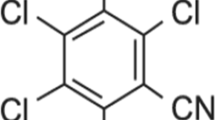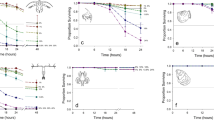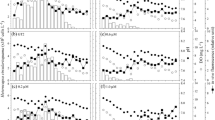Abstract
The effects of the strobilurin fungicide azoxystrobin were studied in brackish water microcosms, with natural plankton communities and sediment. Two experiments were conducted: Experiment 1 (nominal conc. 0, 15 and 60 μg/L, 24-L outdoor microcosms for 21 days) and a second, follow-up, Experiment 2 (nominal conc. 0, 3, 7.5, 15 μg/L, 4-L indoor microcosms for 12 days). The microcosms represent a simplified brackish water community found in shallow semi-enclosed coastal areas in agricultural districts in the Baltic Sea region. Measured water concentrations of the fungicide (Experiment 1) were, on average, 83 and 62% of nominal concentrations directly after application, and 25 and 30% after 21 days, for the low and high dose treatments, respectively, corresponding to mean DT50-values of 15.1 and 25.8 days, for low and high dose treatments, respectively. In Experiment 1, direct toxic effects on calanoid copepods at both test concentrations were observed. Similarly, in Experiment 2, the copepod abundance was significantly reduced at all tested concentrations. There were also significant secondary effects on zooplankton and phytoplankton community structure, standing stocks and primary production. Very few ecotoxicological studies have investigated effects of plant protection products on Baltic organisms in general and effects on community structure and function specifically. Our results show that azoxystrobin is toxic to brackish water copepods at considerably lower concentrations than previously reported from single species tests on freshwater crustaceans, and that direct toxic effects on this ecologically important group may lead to cascade effects altering lower food webs and ecosystem functioning.






Similar content being viewed by others
References
Adielsson S, Kreuger J (2008) Bekämpningsmedel (växtskyddsmedel) i vatten och sediment från typområden och åar samt i nederbörd under 2007. [Pesticides (plant protection products) in water and sediment from agricultural type-areas and rivers and in precipitation during 2007.] Ekohydrologi 104. Report, Swedish University of Agricultural Sciences, ISSN 0347-9307, 52 pp (in Swedish)
Bartlett DW, Clough JM, Goodwin JR, Hall AA, Hamer M, Parr-Dobrzanski B (2002) The strobilurin fungicides. Pest Manag Sci 58:647–662
Berenzen N, Lentzen-Godding A, Probst M, Schulz H, Schulz R, Leiss M (2005) A comparison of predicted and measured levels of runoff-related pesticide concentrations in small lowland streams on a landscape level. Chemosphere 58:683–691
Bester K, Hühnerfuss H (1993) Triazines in the Baltic and North-Sea. Mar Pollut Bull 26:423–427
Cairns JJ (1986) The myth of the most sensitive species: multispecies testing can provide valuable evidence for protecting the environment. Bioscience 36(10):670–672
Castillo LE, de la Cruz E, Ruepert C (1997) Ecotoxicology and pesticides in tropical aquatic ecosystems of Central America. Environ Toxicol Chem 16:41–51
Daam MA, Van den Brink PJ (2007) Effects of chlorpyrifos, carbendazim, and linuron on the ecology of a small indoor aquatic microcosm. Arch Environ Contam Toxicol 53(1):22–35
Elf A, Sandberg T, Bager Y (1997) Azoxystrobin. Fact sheet, Swedish Chemicals Inspectorate, Stockholm, Sweden
European Commission (2001) Guidance document on aquatic ecotoxicology in the frame of the directive 91/414/EEC. Sanco/3268/2001, Health and consumer protection directorate-general
European Commission Peer Review Programme (1997) Azoxystrobin monograph. Rapporteur Member State: Germany
Giddings J, Brock T, Heger W, Heimbach F, Maund S, Norman S, Ratte HT, Schäfers C, Streloke M (2002) Community-level aquatic system studies-interpretation criteria (CLASSIC). Society of Environmental Toxicology and Chemistry, Pensacola
Gorokhova E, Aladin N, Dumont H (2000) Further expansion of the genus Cercopagis (Crustacea, Branchiopoda, Onychopoda) in the Baltic Sea, with notes on the taxa present and their ecology. Hydrobiologia 429:207–218
Gorokhova E, Fagerberg T, Hansson S (2004) Predation by herring (Clupea harengus) and sprat (Sprattus sprattus) on Cercopagis pengoi in a western Baltic Sea bay. ICES J Mar Sci 61:959–965
Hajdu S, Larsson U, Moestrup O (1996) Seasonal dynamics of Chrysochromulina species (Prymnesiophyceae) in a coastal area and a nutrient-enriched inlet of the northern Baltic proper. Botanica Marina 39:281–295
Hansen PJ, Nielsen TG, Kaas H (1995) Distribution and growth of protists and mesozooplankton during a bloom of Chrysochromulina spp (Prymnesiophyceae, Prymnesiales). Phycologia 34:409–416
Hapeman CJ, Dionigi CP, Zimba PV, McConnell LL (2002) Agrochemical and nutrient impacts on estuaries and other aquatic systems. J Agric Food Chem 50:4382–4384
HELCOM (1988) Guidelines for the Baltic Monitoring Program for the third stage; Part D. Biological determinants, Baltic Marine Environment Protection Commission, Helsinki Commission
Jansson B-O (2003) The Baltic Sea. In: Hempel G, Sherman K (eds) Large marine ecosystems of the World. Elsevier, Amsterdam, pp 145–170
Koski M, Breteler WK, Schogt N (1998) Effect of food quality on rate of growth and development of the pelagic copepod Pseudocalanus elongatus (Copepoda, Calanoida). Mar Ecol Prog Ser 170:169–187
Koski M, Rosenberg M, Viitasalo M, Tanskanen S, Sjölund M (1999) Is Prymnesium patelliferum toxic for copepods? - Grazing, egg production, and egestion of the calanoid copepod Eurytemora affinis in mixtures of ‘good’ and ‘bad’ food. ICES J Mar Sci 56(Suppl):131–139
Lauridsen TL, Friberg-Jensen U, Cristoffersen K (2003) Effekter af cypermethrin, azoxystrobin og bentazon på limniske invertebrater. Rep. 76, Miljøstyrelsen, Miljøministeriet (in Danish)
Moestrup Ø (1994) Economic aspects: ‘blooms’, nuisance species, and toxins. In: Green JC (ed) The haptophyte algae. BSC Leadbeater, Oxford, pp 265–285
OECD (2008) OECD (Organization for Economic Cooperation and Development). OECD guidelines for testing of chemicals, Section 2, Guideline 211, Daphnia magna Reproduction Test. OECD Environment Directorate, Paris
Parsons TR, Maita Y, Lalli CM (1984) A manual of chemical and biological methods for seawater. Pergamon, Oxford
Pempkowiak J, Tronczynski J, Pazdro K (2000) Spatial and temporal gradients of triazines in the Baltic Sea of Poland. Mar Pollut Bull 40:1082–1089
Pesticide Ecotoxicity Database (2001) Environmental Fate and Effects Division of Office of Pesticide programs, U.S. EPA, Washington, DC
Quinn GP, Keough MJ (2002) Experimental design and data analysis for biologists. Cambridge University press, Cambridge
Ranger C (1993) Determination of low level nutrients in environmental water samples using flow injection analysis. Int Environ Technol 3(4):21–23
Rautmann D, Streloke M, Winkler R (2001) New basic drift values in the authorisation procedures for plant protection products. In: Forster R & Streloke M (eds) Workshop on risk assessment and risk mitigation measures in the context of the authorization of plant protection products (WORMM), 27–29 September 1999. Mitt Biol Bundesanst. Land-Forstwirtsch, 133–141. Berlin-Dahlem, Heft 381
Slijkerman DME, Baird DJ, Conrad A, Jak RG, van Straalen NM (2004) Assessing structural and functional plankton responses to carbendazime toxicity. Environ Toxicol Chem 23:455–462
Sournia A (1982) Morphological bases of competition and succession. Can J Fish Aquat Sci 210:339–346
Swedish Chemicals Agency (2003) Sold quantities of pesticides 2002. Sveriges Officiella Statistik. Kemikalieinspektionen, Solna (in Swedish)
Swedish Chemicals Agency (2008) Sold quantities of pesticides 2007. Sveriges Officiella Statistik. Kemikalieinspektionen, Solna (in Swedish)
Swedish Chemicals Agency (2009) Proposed water quality objective. Azoxystrobin. Kemikalieinspektionen, Solna. (2009-02-27) http://www.kemi.se/templates/Page.aspx?id=3294
Swedish Standard (1980) Determination of chlorophyll in water—extraction with acetone—spectrophotometric method. SS028146, SIS
Taub FB (1997) Unique information contributed by multispecies systems: examples from the standardized aquatic microcosm. Ecol Appl 7(4):1103–1110
Tomlin CDS (2000) The pesticide manual. British Crop Protection Council, UK
van den Brink PJ, Hattink J, Bransen F, Van Donk E, Brock TCM (2000) Impact of the fungicide carbendazim in freshwater microcosms. II. Zooplankton, primary producers and final conclusions. Aquat Toxicol 48:251–264
Warming TP, Mulderij G, Christoffersen KS (2009) Clonal variation in physiological responses of Daphnia magna to the strobilurin fungicide azoxystrobin. Environ Toxicol Chem 28:374–380
Acknowledgments
We would like to express sincere gratitude to the staff at Askö Marine Laboratory. Stephen Mdachi is acknowledged for his work with the pesticide analyses. The study was kindly supported by financial contributions from Stiftelsen Lars Hiertas Minne and Alice och Lars Siléns fond.
Author information
Authors and Affiliations
Corresponding author
Rights and permissions
About this article
Cite this article
Gustafsson, K., Blidberg, E., Elfgren, I.K. et al. Direct and indirect effects of the fungicide azoxystrobin in outdoor brackish water microcosms. Ecotoxicology 19, 431–444 (2010). https://doi.org/10.1007/s10646-009-0428-9
Accepted:
Published:
Issue Date:
DOI: https://doi.org/10.1007/s10646-009-0428-9




